The Parrot Society UK
Legal Identification Of Stolen Parrots
Legal Identification Of Stolen Parrots©
by R.J.McMillan, Wales, UK
Parrot thefts have been on the increase over the past couple of years, with little or nothing being done by their owners to identify them if they are stolen, these parrots whether one or quite a number are all considered the owner's property.
To claim these Parrots as the owner's property in Law, the owner must be able to positively identify each parrot to the law enforcement agencies or in a court of law. Many owners who can positively identify their stock have not legally been able to get them back because of lack of positive legal proof of ownership.
Methods of Identifying Parrots.
Leg Rings (Bands)
Closed Ring This is one of the most common forms of identification by parrot owners, which usually consists of a solid stainless steel or aluminium ring with a unique identification number or letters impressed in it. The solid rings have to be fitted soon after the parrot chick is hatched. Closed rings are a legal requirement for the identification of CITES Annex A birds. See CITES requirements for marking Annex A birds
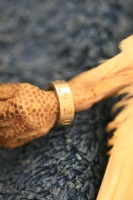
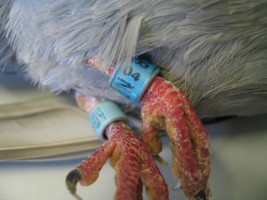
Left - stainless steel closed ring showing breeder's initials, year of hatch ('10) and ring size (U). Right - plastic ID rings on pigeon, again with year number ('04) (AKJ)
Split Ring This type of ring also may be made of stainless steel, aluminium, or plastic, stamped with a unique number/letter code. It may be applied at any age, using special pliers to close the ring, and may be be used to denote sex of the bird once endoscopic or DNA sexing tests have been performed.
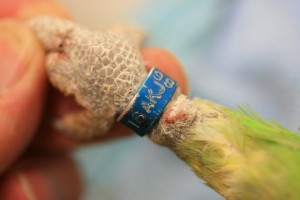
Aluminium split ring placed to indicate sex of bird (blue for male) The ring has rubbed on the leg causing a callus (AKJ)
However leg rings can cause traumas to the legs and feet by getting caught up on perches, wire and associated materials of the aviary or cage construction. These rings are also reasonably easy to remove after the theft. Softer aluminium or plastic rings are easily damaged by parrots, and the former may be squashed on to the leg by the bird's beak, cutting off blood supply to the foot.
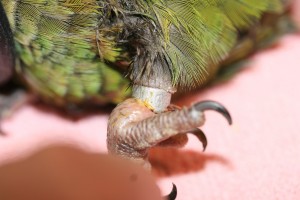
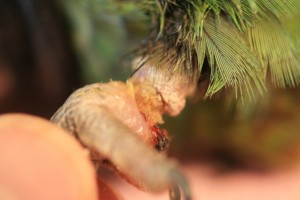
Left - aluminium leg ring squashed on to leg by the bird, resulting in swelling of the foot. Right - ring removed to show damage to underlying flesh. Remarkably, this healed very quickly once the ring had been removed, as the damage to blood supply was fortunately not too far gone (AKJ)
Suitable rings may be obtained by Parrot Society members through the Avian ID Ring Factory in Redruth, Cornwall. For full details see Avian ID
Tattooing
This is another form of identification, especially identifying the sex of the parrot which is tattooed with a combination of numbers and letters, and has been used for entry/exit of parrots to and from foreign countries. Unfortunately this method also has its drawbacks as the tattoos fade and stretch making the numbers or letters of the tattoo illegible.
Wing/Flight Feather Stamping
This form of identification, is carried out by stamping the underside of the flight feathers with a rubber stamp in indelible ink with your name, post code or any other unique number etc. It is commonly used within the pigeon fancy, but is lost when the parrot goes through the moult.
Visual Identity
See below, but Macaws with facial lines of small black feathers have a unique pattern to these lines, and photographic evidence can identify an individual bird on the basis.
Video and Still Photographs
Close up photographs of parrots with physical characteristics such as deformities of toes, feet, legs, eyes, beaks and wings or feathers can assist with identification, as can videos of the parrot's characteristic antics, like talking, whistling, singing, tricks or phrases. However some parrots only perform for their owners and stolen and stressed parrots may not even perform or talk for weeks.
DNA Fingerprinting
This is a unique method to identify your parrot and these days is comparatively inexpensive, yet still not widely available. DNA fingerprinting of all parrots establishes a bird's permanent identification. The degree of relationship to other birds of the same species can be determined with analysis of the birds' DNA profile. This provides positive identification for life in case of theft or loss. DNA fingerprinting can be done on blood samples or feathers.
Individual-specific DNA fingerprints are inherited in the same simple genetic fashion in birds as in mammals and humans, and individual birds are as different from one another as are mammals. The DNA fingerprints are inherited in Mendelian fashion (meaning that these DNA fingerprints are passed from the parents to the progeny) and it is possible to identify those fingerprints inherited from each parent. Each bird has his or her own unique characteristic pattern of DNA fingerprints referred to as their DNA profile. An offspring receives half of its DNA fingerprints from its mother and half from its father. Related birds (e.g. siblings) are expected to share a higher number of their fingerprints than are unrelated birds. The DNA fingerprint is a permanent individual identification for the bird. DNA typing results can help the breeder maintain the genetic constitution of flock and the greatest genetic diversity in progeny. DNA typing results also can be used to get a general idea of which birds would make good mates. This form of genetic coding or fingerprinting is continually becoming more efficient.
Microchipping
This is currently the most widely used and effective legal means of providing positive identification of individual parrots, since it is at present a universally known technique. Technology has produced quite an interesting little device that receives energy via radio waves and sends back a unique serial/identification number. the micro (as in small) electronic components are encased in an inert glass bead the size of a grain of rice. The parrot harmlessly walls off the chip with a layer of scar tissue. These microchips are used by dog and cat owners to help in the finding of lost pets. But how many parrots when stolen are available to be scanned? Thus the main use is for proof of legal origin, ownership and stud book identification. The legal origin question could be backed up by certificates from the Veterinarian who may have removed the closed band and then micro-chipped the bird. The tiny chips are almost impossible to remove in living birds with out doing major tissue damage. It is of course possible to remove the chip from a dead bird, re-sterilize it and inject it back into another bird.
There are many companies around the world selling microchips and the compatible scanner needed to read them. Current technology allows for 'universal scanners' to be able to read many different makes of microchip.
Use of Space Age Technology
SmartWater
Police authorities all over the UK have supported this product and its unique crime prevention and detection possibilities, and are actively promoting it to criminals and looking for SmartWater as a routine part of police procedure. This unprecedented level of support has lead to huge success of this product as a deterrent to criminals.
SmartWater can be used to protect almost anything; it is a forensic deterrent with the potency of providing details of ownership of items instantly, providing an unprecedented degree of identification, so powerful in fact it has been likened to DNA profiling. SmartWater offer two product categories. Firstly they have a property marking system, which is suitable for marking equipment, and other valuable property. Each bottle of SmartWater contains a unique code which is registered on the National Security register, a high security database. Once dry, it is waterproof, almost invisible and extremely long lasting. When applied to property or equipment, it offers conclusive forensic evidence of ownership accepted by a Court of Law. This system should not be used to mark animals or birds directly.
Secondly, SmartWater offers an anti-intruder spray system, which can be used to protect strategic locations, such as the perimeter of aviaries or entrances and exits. The system can be triggered by special detectors, spraying a very fine odourless and colourless liquid onto the intruder(s).
Once dry, it is almost impossible to wash off, so for months afterwards, the thief, together with his clothing, equipment and stolen property or parrots carry indelible traces of SmartWater. It cannot be seen in normal light, but if a suspect is caught, or suspected stolen equipment or parrots found, they can be examined by a simple ultraviolet light, and even if the smallest trace of SmartWater is present, samples can be taken for examination by the SmartWater Forensic Analysis laboratories who can then positively link the suspect, equipment or parrots to a particular theft and the legal owner.
Consequently, no matter wherever the thief hides or keeps the stolen equipment or parrots, the Police can prove in Law the origin of the property or parrots and when and where the theft took place. Criminals in the UK are well aware of the SmartWater’s ability to catch and convict and they tend therefore to leave well alone.
For further details and contacts https://www.smartwater.com
The Parrot Society UK Security advice will support any system or product, which may deter or prevent bird theft. However, as a matter of general policy NO chemicals or sprays should be allowed on or near the birds due to their being highly delicate and sensitive creatures. We advise that all cages, carrying boxes and equipment be permanently marked for future identification should they ever be lost or stolen. This can be done via microdot, UV pens etc but again with no fear of any chemical contamination to the parrots.
SmartWater can be used externally and can be most helpful in the prosecution of offenders if later arrested and there have been a number of successful criminal trials.
Irrespective of its value, please do not rely on it totally. Still maintain high levels of physical and technical security, e.g. infrared beams, alarms, cameras/CCTV and lighting. For the birds themselves, if not close rung fit split rings and microchip by a specialist avian vet.
(Written by John Hayward, past operator of The National Theft Register)
Microdots
This system can be used to protect almost anything. It uses hundreds of 1mm diameter transparent microdots, each of which carries the same unique code. This code can be a postcode or unique serial number. Because these transparent microdots are incredibly hard to spot, a thief may not realize they are there and if he does he can never be sure of removing all of them, making them a powerful deterrent. The police can on recovery use the information on the dots to identify and confirm the real owner almost instantly. At the time of writing this article Microdots could not be used for any 'live' application (i.e. Parrots). The material is not bio-compatible and they are secured in position with an ultraviolet sensitive adhesive, which again is not bio-compatible.
The Ultimate Identification
The ultimate system of identification would cross link leg rings with microchips, Smartwater and some third party holding onto a certified sample of blood for future DNA fingerprinting. This system could prove conclusively ownership of equipment or a stolen parrot even if bands are cut off, and microchips fail to be read. The only problem it would appear is the reluctance of the owners of expensive and sometimes endangered parrots from spending money to positively identify their stock prior to any possible theft, it is too late after they have been stolen!
We will be pleased to receive further articles and information of interest to add to our Web Site or for publication in our Magazine.
Please forward by E-Mail to les.rance@theparrotsocietyuk.org or by post to:
Mr L A Rance
The Parrot Society UK.
Audley House, Northbridge Road
Berkhamsted,
Hertfordshire
HP4 1EH
Telephone 01442 872245
N.B. We review all submitted articles and the society reserve the right not to publish articles at their discretion. Their decision is final in all these matters and no further correspondence will be entered into.
Articles marked with the copyright symbol© beside the author`s name are copyright© the author. In these cases, copyright remains with the author/authors and the information cannot be reproduced without the additional permission of the said author/authors.
